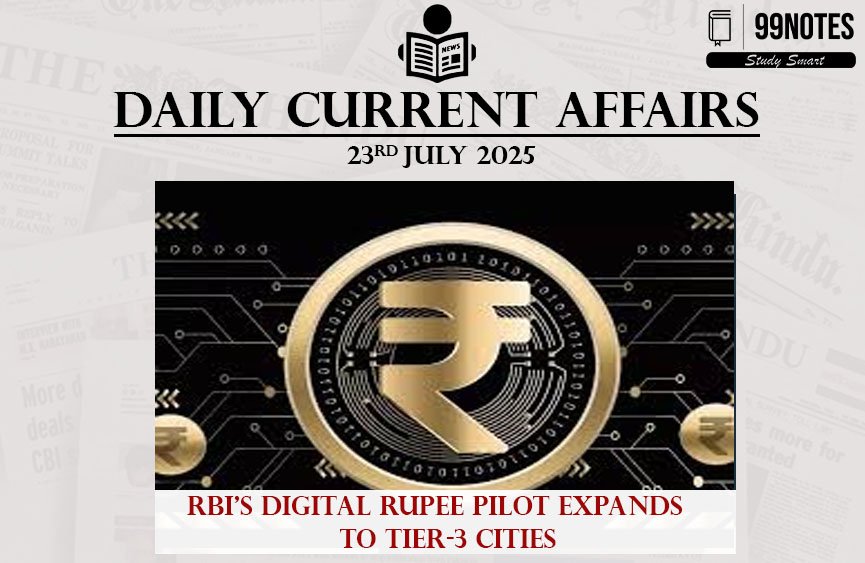23 July 2025 : Daily Current Affairs
1. Dhankhar’s Exit Notified, but Key Questions Remain
Source: Page 1 , The Hindu UPSC IAS Edition
| Topic: GS-2 – Indian Polity and Governance, Parliamentary system |
| Context |
|
Content
Background
-
First Vice-President in India to resign citing health reasons, but underlying political and procedural factors are indicated.
-
His tenure saw active engagement in Rajya Sabha and several confrontations about the process for removing High Court judges.
Constitutional Provisions
-
Article 66(1): Election of Vice-President by an electoral college consisting of members of both Lok Sabha and Rajya Sabha.
-
In the event of resignation/removal, a fresh election must be held immediately as the position cannot be left vacant; no interim succession is provided in the Constitution.
Issues in Focus
-
Government vs. Parliament Dynamics: Dhankhar’s acceptance of an Opposition-backed notice for judicial removal, which the government preferred to originate from Lok Sabha for bipartisanship, led to tensions.
-
Role of Rajya Sabha Chair: His decisions highlighted friction regarding parliamentary supremacy, judicial accountability, and executive influence.
-
Institutional Integrity: Raises the issue of political versus procedural propriety in higher constitutional offices.
Analysis
-
Weakening of independence and parliamentary democracy if high offices become sites for political tussle.
-
Need for clarity and process in removal of judges and robust institutional checks and balances.
Way Forward
-
Immediate election for Vice-President as per constitutional mandate.
-
Review the process and balance of accountability among legislature, executive, and judiciary for future stability in institutions.
Practice Question:
|
“Critically examine the constitutional and political challenges involved in the resignation and replacement of high constitutional offices like the Vice-President of India. What reforms can be suggested to preserve the sanctity and independence of such positions?” (250 words / 15 marks) |
2. Redeeming India’s Nuclear Power Promise
Source: page 9, The Hindu UPSC IAS Edition
| Topic: GS-3 – Energy; GS2 – Government Policies and Interventions |
| Context |
|
Analysis from UPSC Angle:
Background
-
India started early with nuclear research (Apsara, 1956) and power generation (Tarapore, 1963).
-
Historically constrained by international embargoes and internal policy (e.g., CLNDA 2010 limits foreign participation).
Government’s New Plan
-
Budget 2025-26: 100 GW nuclear capacity target by 2047; ₹20,000 crore for small modular reactors (SMRs).
-
Intent to amend Atomic Energy Act, 1962, and CLNDA 2010 to allow private sector and FDI up to 49% for ‘Indian control/ownership’.
Challenges
-
Financing: High capex, low opex, long plant lifespans, costly decommissioning, and waste management.
-
Regulatory: Call for independent nuclear regulatory authority (currently AERB is not a statutory body).
-
Policy and Safety: Tariff setting, commercial dispute mechanism, safety checks with new stakeholders (private/foreign).
-
International Relations: Need for foreign technology and investment; balancing autonomy with global norms.
Analysis
-
Nuclear energy critical for clean, consistent electricity as renewables are intermittent and coal is environmentally unsustainable.
-
Reforms needed in law, regulation, and investment climate to meet targets.
-
Global momentum for nuclear energy (COP28, World Bank–IAEA collaboration).
Way Forward
-
Comprehensive amendments to nuclear laws for private and foreign participation.
-
Enhanced regulatory oversight and incentives for green finance in nuclear sector.
Practice Question:
|
“Discuss the prospects and challenges of involving private and foreign companies in India’s nuclear power sector considering the revised national targets. Suggest a policy roadmap to ensure safety, sustainability, and energy security.” (250 words / 15 marks) |
3. RBI’s Digital Rupee Pilot Expands to Tier-3 Cities
Source: Page 13, Indian Express Delhi Edition
| Topic: GS-3 – Indian Economy; Banking and Financial Inclusion; Science and Tech |
| Context |
|
Key Points for UPSC:
About Digital Rupee (e₹-R)
-
Central Bank Digital Currency (CBDC) introduced in pilot form in late 2022.
-
Operated through public-private retail banks under RBI’s oversight.
-
Offers real-time, token-based digital alternative to physical currency.
Highlights of Current Expansion
-
Pilot now active in 125 cities, including tier-3 towns like Kolhapur, Jabalpur, and Thrissur.
-
Over 35 crore transactions processed since launch.
-
Integrated with UPI and digital wallets in selected banks.
Significance of the move:
-
Financial Inclusion: Reaches digital banking deserts in semi-urban India.
-
Cashless Economy: Pushes behavioral shift especially in low-value retail transactions.
-
Crisis-resilience: Offline payment capabilities tested in power-poor areas.
Policy and Regulatory Impact:
-
RBI evaluating feedback for designing interoperability across digital payment systems.
-
May influence future monetary transmission mechanisms.
Challenges:
-
Infrastructure issues in low-connectivity zones.
-
Lack of digital literacy and potential skepticism.
-
Privacy concerns with centralized data monitoring.
Way Forward:
-
Integrate e₹ with welfare transfer mechanisms directly to citizens.
-
Continue regulatory sandbox approach and involve local-level financial institutions for behavioral uptake
Practice Question:
|
“What are the advantages and limitations of the Digital Rupee (e₹) in the Indian context? How does its implementation support India’s larger economic and financial inclusion goals?” (150 words / 10 marks) |
Check more: 22 July 2025 : Daily Current Affairs





